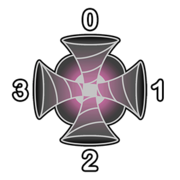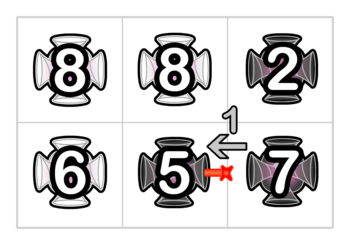CF1740G.Dangerous Laser Power
普及/提高-
通过率:0%
AC君温馨提醒
该题目为【codeforces】题库的题目,您提交的代码将被提交至codeforces进行远程评测,并由ACGO抓取测评结果后进行展示。由于远程测评的测评机由其他平台提供,我们无法保证该服务的稳定性,若提交后无反应,请等待一段时间后再进行重试。
题目描述
Pak Chanek has an n×m grid of portals. The portal on the i -th row and j -th column is denoted as portal (i,j) . The portals (1,1) and (n,m) are on the north-west and south-east corner of the grid respectively.
The portal (i,j) has two settings:
- Type ti,j , which is either 0 or 1 .
- Strength si,j , which is an integer between 1 and 109 inclusive.
Each portal has 4 faces labelled with integers 0,1,2,3 , which correspond to the north, east, south, and west direction respectively.  When a laser enters face k of portal (i,j) with speed xin , it leaves the portal going out of face (k+2+ti,j)mod4 with speed xout=max(xin,si,j) . The portal also has to consume xout−xin units of energy.
When a laser enters face k of portal (i,j) with speed xin , it leaves the portal going out of face (k+2+ti,j)mod4 with speed xout=max(xin,si,j) . The portal also has to consume xout−xin units of energy.
Pak Chanek is very bored today. He will shoot 4nm lasers with an initial speed of 1 , one into each face of each portal. Each laser will travel throughout this grid of portals until it moves outside the grid or it has passed through 10100 portals.
At the end, Pak Chanek thinks that a portal is good if and only if the total energy consumed by that portal modulo 2 is equal to its type. Given the strength settings of all portals, find a way to assign the type settings of each portal such that the number of good portals is maximised.
输入格式
The first line contains two integers n and m ( 1≤n,m≤1000 ) — the number of rows and columns in the grid.
The i -th of the next n lines contains m integers, with the j -th integer being si,j ( 1≤si,j≤109 ) — the strength of portal (i,j) .
输出格式
Print n lines with each line containing a string of length m consisting of characters 0 or 1 representing the type settings. The j -th character in the i -th string is the type setting of portal (i,j) .
If there are multiple solutions, you can output any of them.
输入输出样例
输入#1
2 3 8 8 2 6 5 7
输出#1
110 100
输入#2
1 2 420 69
输出#2
10
说明/提示
In the first example, let's consider the laser Pak Chanek shoots into face 1 of portal (2,2) . The laser travels as follows:
- The laser enters face 1 of portal (2,2) with speed 1 . It leaves the portal going out of face 3 with speed 5 . Portal (2,2) consumes 4 units of energy.
- The laser enters face 1 of portal (2,1) with speed 5 . It leaves the portal going out of face 0 with speed 6 . Portal (2,1) consumes 1 units of energy.
- The laser enters face 2 of portal (1,1) with speed 6 . It leaves the portal going out of face 1 with speed 8 . Portal (1,1) consumes 2 units of energy.
- The laser enters face 3 of portal (1,2) with speed 8 . It leaves the portal going out of face 2 with speed 8 . Portal (1,2) consumes 0 units of energy.
- The laser enters face 0 of portal (2,2) with speed 8 . It leaves the portal going out of face 2 with speed 8 . Portal (2,2) consumes 0 units of energy.
The illustration of the travel of the laser above is as follows.
 As an example, consider portal (2,3) . We can calculate that the total energy consumed by that portal in the end will be 32 . Since 32mod2=0 and t2,3=0 , then it is a good portal.
As an example, consider portal (2,3) . We can calculate that the total energy consumed by that portal in the end will be 32 . Since 32mod2=0 and t2,3=0 , then it is a good portal.